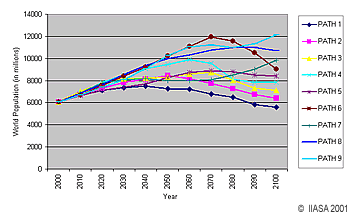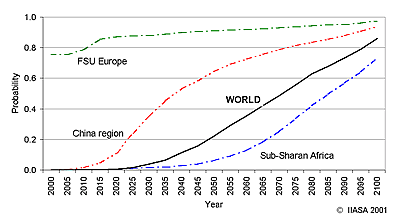Brief summary of results
The projections are carried out using the cohort component method for single years of age and single years in time. The population is calculated by age and sex as it changes from one year to the next, based on the assumptions of fertility and mortality rates, as well as migration. The forecasts are carried out for 13 world regions. The forecasts presented here are not alternative scenarios or variants, but the distribution of the results of 2,000 different cohort component projections. For these stochastic simulations the fertility, mortality and migration paths underlying the individual projection runs were derived randomly from the described uncertainty distribution for fertility, mortality and migration in the different world regions.
Due to increasing globalization of medical technology as well as of new threats to life, it is assumed that the interregional correlations of the deviations from the expected trends in life expectancy improvements are very high. For fertility, increasing globalization of the media as well as reproductive technology are likely to result in high global correlations. For the results presented here, the interregional correlations in the deviations from expected trends were assumed to be 0.9 in the case of life expectancy and 0.7 in the case of fertility.
IIASA-2001-projections-data
In order to discuss 2,000 numbers of each simulation without listing them all, we used the concepts of the median and the deciles of the distribution that they generate. The median, the center of the distribution, tells us that we experience in the year a 50 percent chance of being above and a 50 percent change of being below that number. Results are provided in the inner 95 (lower and upper bounds are the 0.025 and 0.975 deciles), 80 (0.1 to 0.9 deciles), 20 (0.4 to 0.6 deciles) percent intervals, the median, the mean and the standard deviation. The paths of the deciles presented here (the downloads) are smooth; they are derived from the distributions of population size outcomes. Real population paths look like the plot below, where nine paths of those 2,000 are selected.

Download the IIASA-2001 probabilistic forecast results
(1) By the 13 IIASA world regions: median and decile distribution
(as Excel IIASA_projections2001.xls)
- total population
- the proportion of the population age 60 and above,
- the ratio of the population 60 and above to those aged 20 to 59 years (old age
dependency ratio),
- the proportion of the population less than 20 years
(2) By simulation runs (as Excel, zipped, IIASA-2001-projections-data.zip)
- 2,000 simulations of world population size
- North Africa, female population. 1,000 simulations, correlation between
deviations in total fertility rate and deviations in changes in female life
expectancy = -0.9
- North Africa, female population, 1,000 simulations, correlation between
deviations in fertility and life expectancy changes = 0.9
Future world and regional populations and their uncertainties: Examples
The figure below shows the proportion of the 2,000 simulated world population paths whose peak value over the 21st century occurs prior to the date indicated in the x-axis. Around 22 percent of the world paths peak prior to 2050, 56 percent prior to 2075, and 86 percent before 2100. We cannot say with confidence that the world's population growth will come to an end during the 21st century, but we can say that there is a high probability that this will be the case.

When we say that the world's population growth is likely to come to an end during the 21st century, we are not referring to the median or any particular decile. We mean that when we look over the set of 2,000 century-long population futures, in around 85 percent of the cases population growth comes to an end before 2100.
The table below contains information about the dates of population peaks for the 13 world regions and for the world. For instance, there is almost a 40 percent chance that the peak of the Pacific OECD region will have occurred sometime prior to 2025, and almost one-quarter chance in the China region. In around 76 percent of the simulated paths for FSU Europe, the 21st century population peaked already in 2000. It is likely that during this century, the population size of FSU Europe will never be as high as in 2000.
Table: Probability that the maximum value will be reached before the given date
| 2000 | 2025 | 2050 | 2075 | 2100 | |
| World | 0.000 | 0.015 | 0.223 | 0.557 | 0.860 |
| North Africa | 0.000 | 0.005 | 0.094 | 0.363 | 0.753 |
| Sub-Saharan Africa | 0.000 | 0.010 | 0.061 | 0.337 | 0.734 |
| North America | 0.000 | 0.010 | 0.144 | 0.367 | 0.703 |
| Latin America | 0.000 | 0.008 | 0.104 | 0.324 | 0.666 |
| Central Asia | 0.000 | 0.002 | 0.093 | 0.379 | 0.754 |
| Middle East | 0.000 | 0.000 | 0.043 | 0.313 | 0.715 |
| South Asia | 0.000 | 0.009 | 0.260 | 0.681 | 0.924 |
| China Region | 0.000 | 0.241 | 0.644 | 0.814 | 0.937 |
| Pacific Asia | 0.000 | 0.020 | 0.254 | 0.592 | 0.869 |
| Pacific OECD | 0.000 | 0.391 | 0.657 | 0.839 | 0.959 |
| Western Europe | 0.000 | 0.271 | 0.583 | 0.782 | 0.939 |
| Eastern Europe | 0.235 | 0.768 | 0.869 | 0.928 | 0.972 |
| FSU Europe | 0.755 | 0.876 | 0.909 | 0.935 | 0.973 |
By 2100, the regions are distinctly divided into two groups: a) those where the chance of a prior peak is above 80 percent, and b) those where the chance of a prior peak is below 80 percent. The first group includes South Asia, China region, Pacific Asia, Pacific OECD, Western Europe, Eastern Europe, and FSU Europe. The second group is composed of North Africa, sub-Saharan Africa, North America, Latin America, Central Asia, and Middle East (definition of the 13 world regions).
We summarize here the population size and growth rates of two regions: China and sub-Saharan Africa. The China region currently has the most people. In 2000, the population in China was 1.408 billion people. In the median forecast the population rises to 1.618 billion in 2030 and falls to 1.250 billion in 2100. The growth rate of the population averages 0.23 percent per year between 2000 and 2050, and the population shrinks by an average rate of 0.47 percent a year between 2050 and 2100. Even in the 9th decile, population grows at a rate of only 0.02 percent per year during that period. Sub-Saharan Africa is the region of the world where we expect the highest rate of population growth, even after we have taken account of the HIV/AIDS epidemic there. During the first half of the century, the HIV/AIDS epidemic will have the greatest impact on population growth and is somewhere between 1 and 2 percent. In the median forecast the population is expected to more than double, but there is only slightly less than a 10 percent chance that it would triple. Even with rapid population growth early in the century, we can see a population decline in the median forecast for the last two decades (0.611 billion in 2000, 1.319 in 2050, 1.541 in 2080, 1.533 in 2085, and 1.500 in 2000).

Download 2001 probabilistic forecast results

